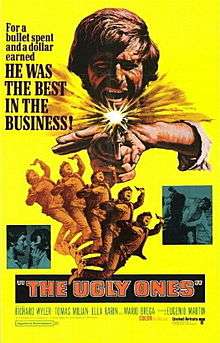The Ugly Ones
| The Ugly Ones | |
|---|---|
 US film poster | |
| Directed by | Eugenio Martín |
| Produced by | José Gutiérrez Maesso |
| Screenplay by |
James Donald Prindle José Gutiérrez Maesso Eugenio Martín |
| Based on |
The Bounty Killer by Marvin H. Albert |
| Starring |
Richard Wyler Tomas Milian Ella Karin Mario Brega |
| Music by | Stelvio Cipriani |
| Cinematography | Enzo Barboni |
| Edited by | José Antonio Rojo |
Production company |
Tescia Discobolo Film |
| Distributed by |
Vincit Films (Spain) Indipendenti Regionali (Italy) United Artists (US) |
Release dates |
9 February 1967 (West Germany) 17 April 1967 (Spain) |
Running time | 95 minutes |
| Country |
Spain Italy |
| Language |
Spanish Italian English |
The Ugly Ones (es: El precio de un hombre, lit. "The Price of a Man", it: The Bounty Killer, later La morte ti segue... ma non ha fretta, lit. "Death follows you... but not in a hurry") is a 1966 Spanish-Italian Spaghetti Western film directed by Eugenio Martín.[1]
The film marked the debut of Tomás Milián in the western genre[2] and was the first film score of composer Stelvio Cipriani. It was also the first Spanish western to receive a state funding for the "artistic interest of the work".[2]
It was shown as part of a retrospective on Spaghetti Western at the 64th Venice International Film Festival.[3]
Plot
The notorious bounty hunter Luke Chilson pursues the Mexican fugitive Jose Gomez. He follows him through the desert only to arrive in a Mexican village where Gomez achieves to turn the peasants against his hunter. Unaware of the danger Chilson finds himself trapped.
Cast
- Tomas Milian as José Gómez
- Richard Wyler as Luke Chilson
- Halina Zalewska as Eden (credited as Ella Karin)
- Mario Brega as Miguel
- Enzo Fiermonte as Novak (credited as Glenn Foster)
References
- ↑ Edger Driscoll Jr. (Oct 11, 1968). "'Ugly Ones' provides plenty of action". Boston Globe. Retrieved 15 August 2012.
- 1 2 Marco Giusti. Dizionario del western all'italiana. Mondadori, 2007. pp. 58–59. ISBN 88-04-57277-9.
- ↑ "La rassegna con Leone e Sergio Corbucci". La Repubblica. July 17, 2007. Retrieved 15 August 2012.